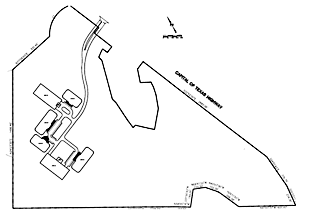A Watershed Year?
By Robert Bryce, Fri., Feb. 6, 1998
|
|
|
These two site plans show the proposed JPI development on Barton Creek Loop 360. The plan on the top, with 57% impervious cover, has already been approved by the city. The plan on the bottom which complies with the Save Our Springs Ordinance, has 15% impervious cover. It will be voted on by the city's board of adjustment on Monday at 6:30 in council chambers. |
"If we can't make this [current plan] work," says JPI's Carpenter, "we will pursue this [older] plan, which we think is a lousy plan." Carpenter admits the existing approvals are "lousy" for several reasons: The apartment market in Austin has softened and JPI will not make as much money on apartments as it will on office space. In addition, extending Westgate would be an expensive, time-consuming task that gives JPI very little return on its investment. And by forgoing the extension, JPI gets back about half a million dollars in deposits that it has given to the city.
Despite JPI's threat to build nearly four times the impervious cover allowed by S.O.S., the Save Our Springs Alliance opposes the height variance, and has asked the city to look at the traffic congestion that could be caused by the project. City officials have estimated the project will add 4,951 vehicle trips per day to the Loop 360 corridor. In a Jan. 20 letter to the city council, the S.O.S. Alliance, Austin Sierra Club, and Barton View Neighborhood Association asked that the city instead "preserve the site through trade, sale, donation or other transfer of the site for conservation purposes."
But there's a problem: The city doesn't have the money to buy the property. And Slusher, who has been negotiating with Carpenter for nearly a year, says he is not going to ask the council to consider buying the property without voter approval. (Purchasing the land could be included in a bond proposal package that will go before voters later this year, but no formal recommendations have been made.) While Slusher sympathizes with the S.O.S. Alliance's desire to keep the Brodie tract undeveloped, he says he is "dismayed" by their lack of support for his efforts to bring the project into compliance with S.O.S. "I'd like to have no development there, too," said Slusher. "The reason I went to the developers in the first place was that the level of development approved there was so high." He says that if developers agree to bring their projects into compliance with S.O.S. and then environmentalists don't support the project, "it's going to dampen enthusiasm for voluntary compliance." And now that JPI has agreed to reduce the amount of development, Slusher says, "There's only so much you can do. You either negotiate down in the name of community values, or you buy it from them."
Regardless of what happens with the JPI proposal, the city has several other projects that are as large or larger than this one, all in the same immediate area. All will affect water quality in Barton Creek, while increasing traffic on MoPac, Loop 360, and adjacent roads. The Terrace, a 100-acre project owned in part by former gubernatorial candidate Clayton Williams, has approvals for 912,000 square feet of mixed-use development, and has begun construction. Five other projects - Las Cimas, The Setting, Barton Ridge Plaza, Barton Creek Plaza, and Temple Inland - contain more than 1.5 million square feet of office space; all are either under construction or approved.
Mary Arnold, an S.O.S. Alliance board member and former head of the city's Planning Commission, says, "There's been aggressive annexation, but we still don't have from the city any sort of real numbers in terms of what we are facing" regarding growth in the Barton Springs watershed.
How will the city deal with future projects like JPI? Mayor Kirk Watson agrees that the council has not been able to focus on that problem, but he hopes that in the coming weeks they'll be able to develop what he calls a "smart growth initiative" that will include revisions to the land development code. Watson says the initiative will include three elements: incentives for developers to move projects out of the Barton Springs Zone, a land purchase plan for the zone, and tradable development rights.
Until those reforms are in place, Watson says, the city is going to have to do some horse trading when it comes to projects in the Barton Springs watershed, including the one being pushed by JPI. "We have to go for the best project possible and that means that S.O.S. and water quality have to be the core components," Watson said.
In the meantime, despite the S.O.S. Alliance's opposition, the JPI proposal appears to have the backing of the council, with Watson and other councilmembers predicting that if the Board of Adjustment approves the height variances, the council will do the same. The adjustment board will meet at 6:30pm Monday in council chambers to consider JPI's height variance proposal.
Got something to say on the subject? Send a letter to the editor.










